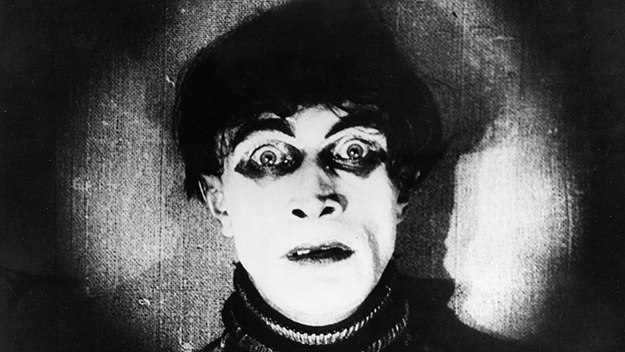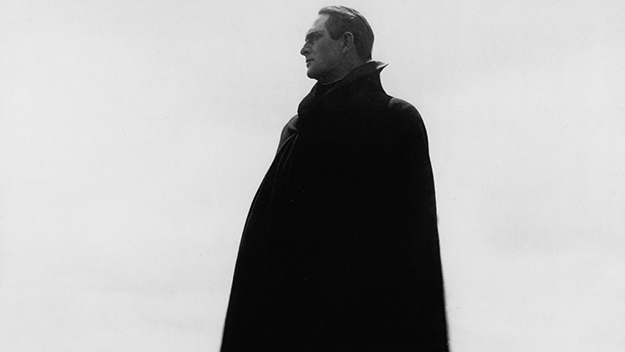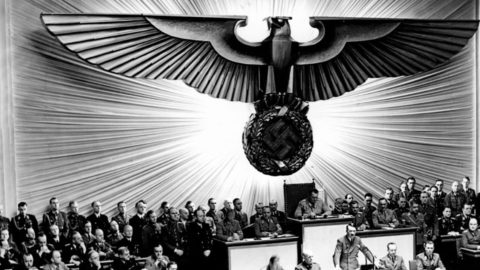Higher Learning: Hero Worship
Higher Learning is a regular feature at Film Comment in which university scholars share concise essays bringing our readers into the rich and varied conversations occurring in the fields of film and moving-image studies.

Avengers: Endgame (Anthony Russo and Joe Russo, 2019)
The idea that a nation represents its history to itself at the movies is an old and familiar one. The work of Steven Spielberg, Errol Morris, Ava DuVernay, Raoul Peck, and Oliver Stone remind those of us in older generations of the things we lived through and forgot in the rush of oncoming news; their pop-cultural function has been to transmute current events into capital-H history, transmit the recent past to those too young to know it firsthand, and bring older historical events back into alignment with troubling aspects of the present moment. At their best, documentaries and historical drama let us “work through” the past as a community, bringing to life that elusive abstract concept, the “national conversation.” After all, what is a nation but an imagined community that we all discuss and fantasize together (according to political theorist Benedict Anderson)?
But what happens when the films that express a given moment in time are not overtly political? What if, instead, they express the political moment obliquely, in encryption, giving covert form to our deepest collective wishes and fears? What if, in fact, zombie invasions and superheros, star wars, alien catastrophes and, still, even now, the long shadow of César, semi-living murderer in Robert Wiene’s 1920 silent horror film The Cabinet of Dr. Caligari, best represent the current historical moment, charting it as sensitively as the most conscientious documentarian?
The great film historian Siegfried Kracauer certainly thought so, in his classic study From Caligari to Hitler, which he wrote from exile in New York City (and which Princeton University Press reprinted this year as part of its Princeton Classics series). Kracauer pegged the study as a psychological history of the German people as much as it was film critique. In the book, he makes very clear he does not think there are any immutable characteristics of Germans as a group that would make them more prone to tyrannical fantasies, or films that spectacularize fascism. He does not truck with the notion of a fixed national character, but he does believe that if you make a wide enough survey of the films being made and watched in a given place at a particular historical moment in time, you can understand a lot about a group’s hidden wishes and fears. The screening room of a film theater is a darkened dreaming-space for Kracauer, where we silently watch images, alone together. Movies have the potential to reveal collective preoccupations, because they are collaborative production, made for what Kracauer called “the anonymous multitude,” and mandated to appeal to a substantial audience if they are to make a profit (or an impact). Even genres that attempt to manufacture audience desires, like Hollywood blockbusters or Leni Riefenstahl’s Nazi propaganda films, must still connect to widespread audience interests.
Kracauer analyzes a broad swath of German Ufa output form many genres in order to diagnose the hate-love relationship with authoritarianism that he sees in Weimar Germany. It is striking how many of the most important or influential films from that era are science fiction, especially because science fiction at the time was a new genre descended from the “scientific romance” or “utopian tale.” The line between science and alchemy is not strictly drawn in these films, which is why the mad scientist who creates the robot Maria in Fritz Lang’s Metropolis (1927) appears to live in a fairy-tale wizard’s den squatting next to the skyscrapers of a modern city, or why technology so often resembles magic. For example, we are told that Dr. Caligari uses the science of mesmerism to control César and order the murders that he commits, but you would be forgiven for thinking César was a vampire based on visual images alone. Once the category of science fiction is understood expansively in this way, the number of early science fiction and superhero films in the Weimar-era repertoire skyrockets. Why would science fiction and all-powerful superheroes be so popular then—why might they be a response to extreme and rapid political change?

The Cabinet of Dr. Caligari (Robert Wiene, 1920)
The answer is no different than the reason for their popularity in the current moment, in an era of X-Men, Transformers, and all manner of Avengers: these films illustrate our fears and animate our wishful thinking during a period of upheaval. Or, as Kracauer puts it, “the dissolution of political systems results in the decomposition of psychological systems, and in the ensuing turmoil traditional inner attitudes, now released, are bound to become conspicuous, whether they are challenged or endorsed.” This was particularly true of middle-class Germans in the 1920s, who still believed in middle-class ideology and ideals from the past even though their actual economic and social status was sinking, and bordered on or in some cases had become lower than that of workers. Unable to accept the fast changes that followed on the heels of Germany’s defeat in World War One or to accept the legitimacy of the Weimar government founded on the basis of the “revolution” against the Kaiser that followed defeat, they did not support their moderate socialist parliament nor did they defend the Weimar government against the communists or the fascists agitating for its destruction. Kracauer calls this disassociation from reality a stubborn “mental forlornness,” an emotional fixation that enabled them to avoid facing facts, and the trait gave them an appetite for early science fiction at the same time as it caused the passivity that led to the acceptance of Hitler’s putsch.
Fantasy and science fiction films of this period fall into three overlapping categories: films that celebrate new technologies; films that explore the limits of what it means to be human and question the difference between men and machines; and films that imagine radical changes in social organization and the possibilities of both utopia and dystopia, sometimes on other planets or under different ecological conditions on earth. In the first category you find apparently realist films like Walter Ruttmann’s Berlin: Symphony of a Great City (1927) as well as Metropolis, Lang’s Woman in the Moon (1929), and Wiene’s The Hands of Orlac (1924; featuring a pianist who undergoes the surgical transplantation of hands donated by a recently executed murderer, and is conned into believing that the hands forced him to murder his own father). The second category is deeply extensive, but a few highlights include Metropolis again of course, as well as The Student of Prague (1913 and remade again in 1926, each time starring a student who makes the Faustian bargain of selling his mirror reflection for gold); multiple films titled Golem, based on the Jewish folk tale of a clay figure brought to life by a rabbi; F.W. Murnau’s Nosferatu; and Otto Rippert’s Homunculus (1916), about a Frankensteinian experiment run amok. Metropolis endures as a shining example of the third category as well, as do, among others, Hans Werkmeister’s Algol: a Tragedy of Power (1920; featuring a miner who encounters an alien from the planet Algol offering a perpetual energy machine; this charmer stars Emil Janning, with art direction by Paul Scheerbart), and Arnold Fanck’s mountain films (Bergfilme), which constituted a genre of their own in prewar Germany. A personal favorite is Storm over Mont Blanc (1930), which features an amazing visual sequence of a woman operating a colossal meteorological telescope five times her size, as well as idyllic visions of mountain life—communal flocks of playful skiers, a daredevil pilot who connects people living on remote peaks, and the idealized paternal relationship between weather scientists.
A major theme running through many of these films is a larger-than-life protagonist with extraordinary powers able to rebuild society. Of course, this idea was popular on both sides of the Atlantic before and during World War Two, as we know from Superman, the archetypal superhero created in Ohio in 1933 and sold to DC Comics in 1938. The name “Superman” is a direct translation of Nietzsche’s Übermensch, a figure prophesied in Thus Spoke Zarathustra (1896) as a goal for humanity, a person whose strength and willpower will transcend the egalitarian value systems and mediocrity of modern men. However, for me it takes its most revelatory form in Rippert’s serial Homunculus.
This is a story worth recounting in full. It stars a protagonist who was created in a machine resembling an enormous Wurlitzer jukebox by a scientist who then switched him at birth with a friend’s dead baby. Homunculus grows up unaware of his true identity and tormented by his inability to feel love. When he learns of the deception, he feels betrayed, and marries his creator’s daughter in an act of revenge. His creator tries to poison Homunculus, but his wife drinks the poison instead and dies. Deeply disillusioned, Homunculus wanders the earth, effecting miracle cures in distant parts of the globe through sheer force of his artificial scientific willpower but meeting with ingratitude and betrayal wherever he goes, particularly at the hand of mobs, who drive him out of various places, kill his beloved pet dog, and try to destroy the diary where he writes his inmost thoughts. Homunculus is shot from below throughout, the camera lengthening his stature as well as the long black cape that moodily sweeps behind him.

Homunculus (Otto Rippert, 1916)
Eventually, this powerful figure invents an incendiary chemical and becomes a wealthy factory owner, oppressing the masses while at the same time working as a radical agitator getting the downtrodden to revolt so that they can be destroyed. Foiled again in his plot to destroy humankind, Homunculus adopts an adolescent boy and girl and takes them to a remote island, hoping to using them to breed a new race of human beings unconstrained by civilization. When the plan fails and the boy turns on him, trying to kill him in his sleep, Homunculus is disgusted and floods the island, killing the young couple and their newborn baby. Finally, his only friend, a hunchback named Rodin, is so horrified by his behavior that he decides to create a new homunculus who will kill the old one. Homunculus manages to defeat his new double, but their struggle is so titanic that it causes a mountain to collapse upon them as they fight, killing and entombing Homunculus forever in one fell stroke.
Even a mere synopsis of Homunculus (shown in six parts totaling 200-plus minutes) makes clear some of the illuminating differences between German science fiction films of the Weimar era and the current day. Science and technology are still confused with alchemy, devils’ bargains, and mysticism in these films rather than cybernetics or gene technology. Twentieth-century German superheroes are threatened by powerful sexualized women, unlike Wonder Woman and other films where women are the superheroes, and follow the same plot formulas as the men, acting in the same mold Batman or Spiderman. Most strikingly, however, for me at least, superheroes from the Weimar era are ambivalent figures, like the Homunculus who commits evil acts but only because of the original betrayal he experienced: he was created without an ability to feel love, for which he longs. Even in his disillusionment he still strives for love, especially in his relationship to his pet dog and his rapport with some of the hapless women who fall in love with him. Weimar superheroes contain the potential for good and evil—like the massed crowds they confront and represent. Twenty-first century superheroes in America, by contrast, seem to be all good or all bad, whether they are Jedi from Star Wars, Amazons versus Nazis in Wonder Woman, Optimus Prime versus Decepticons, or Loki versus the band of Avengers defending the human race. Like Weimar Germans, we enjoy the escapist wish fulfillment of an all-powerful superhero defeating his enemies, but unlike them, we need it to take place in a clear moral universe where good guys confront villains, or go through psychological crises that do not truly leave the outcome in doubt. We need innocence.
This is, in a word, the ideal of the strongman; there is something fascistic at play anytime one superhuman figure can represent or save all of the rest of humanity. Much of Weimar cinema is openly saturated with both far-left and far-right ideas, like the progressive young Freder of Metropolis, the leader or “heart” who unifies the entire body politic beneath him even while he apparently is organizing a redistribution of wealth to benefit workers. Our current crop of superheroes often mouth progressive values, championing the rights of women and minorities, people perceived as different from the norm. But our obsessive interest in them indicates a sense of powerlessness that seeks fulfillment in transcendent power, and a sublimated pleasure in smashing and destroying civilized order, like the Weimar Germans. However, the desperately rigid moral order we impose on our science fiction and superhero fantasies indicate a deeper threat: a dislocated sense of the falsification of reality promoted by truthiness and fake news that has caused us to lose our bearings. The Weimar Germans knew at least they were in a period of radical change, or Aufbruch, as they put it. This alone was not enough to prevent the madness of Nazism from taking hold of a society, but at least the threat was perceived as intimately, contaminatingly real. Perhaps we are in denial.
Christina Svendsen is an assistant professor of German at Centre College, a writer, and a translator of experimental fiction, including Unica Zürn’s The Trumpets of Jericho and Paul Scheerbart’s speculative fictions Lesabéndio: an Asteroid Novel and Munchausen and Clarissa (forthcoming soon from Wakefield Press).






